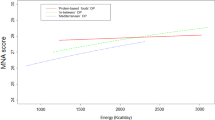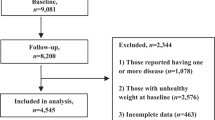Abstract
Objective: To evaluate dietary quality of European and American elderly subjects using different derivatives of dietary patterns (dietary scores and clusters) and to investigate the relationship of these approaches to nutritional and lifestyle factors.
Design: Data from the cross-sectional SENECA baseline study and Framingham Heart Study (original cohort and offspring) were used for data analysis. Food intake data were summarised into dietary clusters and into dietary scores (Healthy Diet Indicator and Mediterranean Diet Score). These measures of dietary quality were then tested for associations with lifestyle factors and measures of nutritional status.
Subjects/Setting: The study population, aged 70–77 y, consisted of 828 subjects from Framingham, MA (USA) and 1282 subjects from the following European centres: Hamme, Belgium; Roskilde, Denmark; Padua, Italy; Culemborg, The Netherlands; Vila Franca de Xira, Portugal; Betanzos, Spain; and Yverdon, Burgdorf and Bellinzona, Switzerland.
Results: Dietary intake varied widely across the European and American research centres. In general, Southern European centres and Framingham had higher mean diet scores, indicating a higher dietary quality, than Northern European centres (MD-scores: 4.2–4.4 vs 2.7–3.5). Cluster analysis identified the following five dietary patterns characterised by: (1) sugar and sugar products; (2) fish and grain; (3) meat, eggs and fat; (4) milk and fruit; and (5) alcohol intake. The meat, eggs and fat pattern had significantly lower average dietary quality, as measured with all three diet scores than all other groups except the alcohol group. The fish and grain group had significantly better Mediterranean diet scores than all other groups.
Conclusions: Dietary scores and dietary clusters are complementary measures to classify dietary quality. The associations with nutritional and lifestyle factors indicate the adequate categorisation into dietary quality groups.
Sponsorship: European Union, US Department of Agriculture, Agriculture Research Service, under agreement (58-1950-9-001), Haak Bastiaanse-Kuneman Foundation.
European Journal of Clinical Nutrition (2001) 55, 870–880
This is a preview of subscription content, access via your institution
Access options
Subscribe to this journal
Receive 12 print issues and online access
$259.00 per year
only $21.58 per issue
Buy this article
- Purchase on Springer Link
- Instant access to full article PDF
Prices may be subject to local taxes which are calculated during checkout
Similar content being viewed by others
References
Akin JS, Guilkey DK, Popkin BM & Fanelli MT (1986) Cluster analysis of food consumption patterns of older Americans J. Am. Diet. Assoc. 86 616–624
Amorim Cruz JA, Haveman-Nies A, Schlettwein D & Matthijs C (2001) Geographical differences in 10-year mortality in the SENECA elderly J. Nutr. Health Aging (in press).
Arab L, Wittler M & Schettler G (1987) European Food Composition Tables in Translation Berlin: Springer
Boeing H, Klein U & Hendrichs A (1989) Strategies for analysing nutritional data for epidemiological purposes—food patterns by means of cluster-analytical procedures Nutr. Rep. Int. 40 189–198
Cade JE & Margetts BM (1991) Relationship between diet and smoking—is the diet of smokers different? J. Epidemiol. Community Health 45 270–272
Dawber TR (1980) The Framingham Study Cambridge, MA: Harvard University Press
Dawber TR, Meadors GF & Moore FE (1951) Epidemiological approaches to heart disease: the Framingham study Am. J. Public Health 41 279–286
De Groot CPGM & van Staveren WA (1988) Nutrition and the Elderly: Manual of Operations. Report 11. Wageningen: Euronut
De Groot CPGM, Sette S, Zajkás G, Carbajal A & Amorim Cruz JA (1991) Nutritional status: anthropometry Eur. J. Clin. Nutr. 45 (Suppl 3), 31–42
De Groot L(C)PGM, van Staveren WA & Burema J (1996) Survival beyond age 70 in relation to diet Nutr. Rev. 54 211–212
Dirren H, Decarli B, Lesourd B, Schlienger JL, Deslypere JP & Kiepurski A (1991) Nutritional status: haematology and albumin Eur. J. Clin. Nutr. 45 (Suppl 3), 43–52
Farchi G, Fidanza F, Mariotti S & Menotti A (1994) Is diet an independent risk factor for mortality? 20 y mortality in the Italian rural cohorts of the Seven Countries Study. Eur. J. Clin. Nutr. 48 19–29
Greenwood DC, Cade JE, Draper A, Barrett JH, Calvert C & Greenhalgh A (2000) Seven unique food consumption patterns identified among women in the UK Women's Cohort Study Eur. J. Clin. Nutr. 54 314–320
Haines PS, Siega-Riz AM & Popkin BM (1999) The Diet Quality Index revised: a measurement instrument for populations J. Am. Diet. Assoc. 99 697–704
Hair, JF, Anderson RE, Tatham RL & Black WC (1992) Multivariate Data Analysis with Readings, 3rd edn. New York: Maxwell Macmillan International
Haveman-Nies A, de Groot L(C)PGM & van Staveren WA (1998) Snack patterns of older Europeans J. Am. Diet. Assoc. 98 1297–1302
Hu FB, Rimm E, Smith-Warner A et al (1999) Reproducibility and validity of dietary patterns assessed with a food-frequency questionnaire Am. J. Clin. Nutr. 69 243–249
Huijbregts PPCW, Feskens EJM & Kromhout E (1995) Dietary patterns and cardiovascular risk factors in elderly men: the Zutphen elderly study Int. J. Epidemiol. 24 313–320
Huijbregts PPCW, Feskens EJM, Räsänen L, Fidanza F, Nissinen A, Menotti A & Kromhout D (1997a) Quality of dietary pattern and 20-year mortality in elderly men in Finland, Italy and The Netherlands Br. Med. J. 315 13–17
Huijbregts PPCW, de Vegt F, Feskens EJM., Bowles CH & Kromhout D (1997b) Dietary patterns and mortality in an elderly population in The Netherlands. A comparison between cluster analysis and the healthy diet indicator. PhD thesis
Hulshof KFAM, Wedel M, Löwik MRH, Kok FJ, Kistemaker C, Hermus RJJ, Ten Hoor F & Ockhuizen Th (1992) Clustering of dietary variables and other life-style factors (Dutch Nutrition Surveillance System) J. Epidemiol. Community Health 46 417–424
Hulshof KFAM, Löwik MRH, Kistemaker C, Hermus RJJ, ten Hoor F & Ockhuizen T (1993) Comparison of dietary intake data with guidelines: some potential pitfalls (Dutch nutrition surveillance system) J. Am. Coll. Nutr. 12 176–185
Jacques PF, Sulsky SI, Sadowski JA, Phillips JC, Rush D & Willett WC (1993) Comparison of micronutrient intake measured by a dietary questionnaire and biochemical indicators of micronutrient status Am. J. Clin. Nutr. 57 182–189
Jain M, Howe GR & Rohan T (1996) Dietary assessment in epidemiology: comparison on food frequency and a dietary history questionnaire with a 7-day food record Am. J. Epidemiol. 143 953–960
Kannel WB & Sorlie PD (1979) Some health benefits of physical activity: the Framingham study Arch. Intern. Med. 139 857–861
Kant AK (1996) Indexes of overall diet quality: a review J. Am. Diet. Assoc. 96 785–791
Kennedy ET, Ohls J, Carlson S & Fleming K (1995) The Healthy Eating Index: design and applications. [See comments]. J. Am. Diet. Assoc. 95 1103–1108
Lasheras C, Fernandez S & Patterson AM (2000) Mediterranean diet and age with respect to overall survival in institutionalized, nonsmoking elderly people Am. J. Clin. Nutr. 71 987–992
Löwik MRH, Hulshof KFAM & Brussaard JH (1999) Food-based dietary guidelines: some assumptions tested for The Netherlands Br. J. Nutr. 81 (Suppl 2), S143–S149
Ma J, Hampl JS & Betts NM (2000) Antioxidant intakes and smoking status: data from the Continuing Survey of Food Intakes by Individuals 1994–1996 Am. J. Clin. Nutr. 71 774–780
Margetts BM & Jackson AA (1993) Interactions between people's diet and their smoking habits: the dietary and nutritional survey of British adults. [See comments.] Br. Med. J. 307 1381–1384
Millen BE, Quatromoni PA, Franz MM, Epstein BE, Cupples LA & Copenhafer DL (1997) Population nutrient intake approaches dietary recommendations: 1991 to 1995 Framingham nutrition studies J. Am. Diet. Assoc. 97 742–749
Molarius A, Seidell JC, Sans S, Tuomilehto J & Kuulasmaa K (1999) Waist and hip circumferences, and waist-hip ratio in 19 populations of the WHO MONICA Project Int. J. Obes. Relat. Metab. Disord. 23 116–125
Nes M, van Staveren WA, Zajkás G, Inelmen EM & Moreiras-Varela O (1991) Validity of the dietary history method in elderly subjects Eur. J. Clin. Nutr. 45 (Suppl 3), 97–104
Oltersdorf U, Schlettwein GD & Winkler G (1999) Assessing eating patterns–an emerging research topic in nutritional sciences: introduction to the symposium Appetite 32 1–7
Osler M & Schroll M (1997) Diet and mortality in a cohort of elderly people in a north European community Int. J. Epidemiol. 26 155–159
Patterson RE, Haines PS & Popkin BM (1994) Diet Quality Index: Capturing a multidimensional behavior J. Am. Diet. Assoc. 94 57–64
Rimm EB, Giovanncci EL, Stampfer MJ, Colditz GA, Titin LB & Willett WC (1992) Reproducibility and validity of an expanded self-administered semiquantitative food frequency questionnaire among male health professionals Am. J. Epidemiol. 135 1114–1126
SAS Institute Inc (1990) SAS/STAT User's Guide version 6, 3rd edn. Cary, NC: SAS Institute
Schroll K, Carbajal A, Decarli B, Martins I, Grunenberger F, Blauw YH & De Groot CPGM (1996) Food patterns of elderly Europeans Eur. J. Clin. Nutr. 50 (Suppl 2), S86–S100
Trichopoulou A & Lagiou P (1997) Healthy traditional mediterranean diet: an expression of culture, history, and lifestyle Nutr. Rev. 55 383–389
Trichopoulou A, Kouris BA, Wahlqvist ML, Gnardellis C, Lagiou P, Polychronopoulos E, Vassilakou T, Lipworth L & Trichopoulos D (1995a) Diet and overall survival in elderly people Br. Med. J. 11 1457–1460
Trichopoulou A, Kouris-Blazos A, Vassilakou T, Gnardellis C, Polychronopoulos E, Venizelos M, Wahlqvist ML & Trichopoulos D (1995b) Diet and survival of elderly Greeks: a link to the past Am. J. Clin. Nutr. 61 S1346–S1350
Tucker KL, Dallal GE & Rush D (1992) Dietary patterns of elderly Boston-area residents defined by cluster analysis J. Am. Diet. Assoc. 92 1487–1491
Van't Hof MA, Hautvast JGAJ, Schroll M & Vlachonikolis G (1991) Design, methods and participation Eur. J. Clin. Nutr. 45 (Suppl 3), 5–22
Voorrips LE, Ravelli ACJ, Dongelmans PCA, Deurenberg P & van Staveren WA (1990) A physical activity questionnaire for the elderly Med. Sci. Sports Exerc. 23 974–979
Willett WC, Sampson L, Stampfer MJ et al (1985) Reproducibility and validity of a semiquantitative food frequency questionnaire Am. J. Epidemiol. 122 51–65
Wirfält AKE & Jeffery RW (1997) Using cluster analysis to examine dietary patterns: nutrient intakes, gender, and weight status differ across food pattern clusters J. Am. Diet. Assoc. 97 272–279
WHO (1990) Diet, nutrition, and the prevention of chronic diseases Report of a WHO Study Group WHO Technical Report Series no. 797. Geneva: WHO
WHO (1994) World Health Statistics Annual 1993 Geneva: WHO
Acknowledgements
This study is part of the EU/SENECA study on Nutrition and Health of the Elderly in Europe. The authors wish to thank all principal investigators and collaborators of SENECA's baseline study. This study was supported in part by the US Department of Agriculture, Agricultural Research Service (58-1950-9-001), under agreement, and a grant from the Haak Bastiaanse-Kuneman Foundation.
Author information
Authors and Affiliations
Corresponding author
Rights and permissions
About this article
Cite this article
Haveman-Nies, A., Tucker, K., de Groot, L. et al. Evaluation of dietary quality in relationship to nutritional and lifestyle factors in elderly people of the US Framingham Heart Study and the European SENECA study. Eur J Clin Nutr 55, 870–880 (2001). https://doi.org/10.1038/sj.ejcn.1601232
Received:
Revised:
Accepted:
Published:
Issue Date:
DOI: https://doi.org/10.1038/sj.ejcn.1601232
Keywords
This article is cited by
-
Effects of high-protein diet combined with exercise to counteract frailty in pre-frail and frail community-dwelling older adults: study protocol for a three-arm randomized controlled trial
Trials (2020)
-
Time trends in nutrient intake and dietary patterns among five birth cohorts of 70-year-olds examined 1971–2016: results from the Gothenburg H70 birth cohort studies, Sweden
Nutrition Journal (2019)
-
High starchy food intake may increase the risk of adverse pregnancy outcomes: a nested case-control study in the Shaanxi province of Northwestern China
BMC Pregnancy and Childbirth (2019)
-
Self-reported socio-economic status, social, physical and leisure activities and risk for malnutrition in late life: A cross-sectional population-based study
The Journal of nutrition, health and aging (2011)
-
Associations between healthy eating patterns and indicators of metabolic risk in postmenopausal women
Nutrition Journal (2010)



